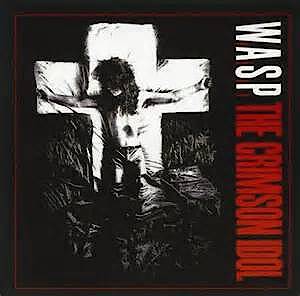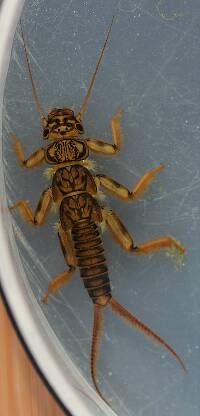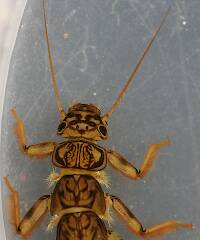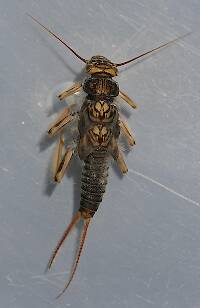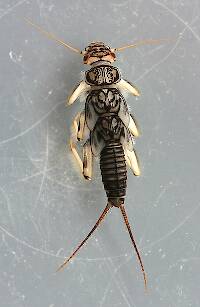
Hex Mayflies
Hexagenia limbata
The famous nocturnal Hex hatch of the Midwest (and a few other lucky locations) stirs to the surface mythically large brown trout that only touch streamers for the rest of the year.
Featured on the forum

I caught this tiny larva without a case, but it seems to key pretty clearly to to Glossosomatidae. From there, the lack of sclerites on the mesonotum points to either Glossosoma or Anagapetus. Although it's difficult to see in a 2D image from the microscope, it's pretty clear in the live 3D view that the pronotum is only excised about 1/3 of its length to accommodate the forecoxa, not 2/3, which points to Glossosoma at Couplet 5 of the Key to Genera of Glossosomatidae Larvae.

Troutnut is a project started in 2003 by salmonid ecologist Jason "Troutnut" Neuswanger to help anglers and
fly tyers unabashedly embrace the entomological side of the sport. Learn more about Troutnut or
support the project for an enhanced experience here.
Adirman on Aug 30, 2010August 30th, 2010, 6:55 am EDT
Hi;
I was wondering if someone could give me some tips/pointers on basic id'ing. for the 1st several yrs I flyfished, I ignored that aspect fo the sport and focused on casting, rigging, knots, etc. Know that i'm more proficient in those other areas, I want to get better at id'ing the bugs! I'm sure i can tell caddis from mayflies and spinnersIin most cases) from duns but its hard for me to sort out the nymphs. Example, yesterday, me and a buddy went fishing and he pointed out to me all the empty Iso shucks from the nymphs emerging. When I looked at them, the color looked right(sorta brownish red?)but honestly, they kinda looked like stoneflies as well. Any easy way to tell the difference?
Thanks,
Adirman
GONZO on Aug 30, 2010August 30th, 2010, 8:05 am EDT
Any easy way to tell the difference?
Yes. Stonefly nymphs will typically have two wingcases (one behind the other) and two tails. Isonychia nymphs will appear to have one wingcase (they have a second to house the smaller hindwings, but it is hidden under the first) and three (fringed) tails. Although Isonychia nymphs have rather long antennae for a mayfly, they are not as conspicuous as most stonefly antennae.
As a general guide to some of the easily observable differences, this link to Roger's website should help:
http://www.flyfishingentomology.com/Aquatic%20Insect%20Recognition.htm
Quick Reply
Related Discussions
Topic
Replies
Last Reply
1
Jan 29, 2016
by Martinlf
by Martinlf
Re: Help to get some specimens of the isopod Caecidotea communis
In the Arthropod Family Asellidae by Leonardo
In the Arthropod Family Asellidae by Leonardo
11
Mar 29, 2013
by Leonardo
by Leonardo
1
Apr 18, 2007
by Troutnut
by Troutnut


